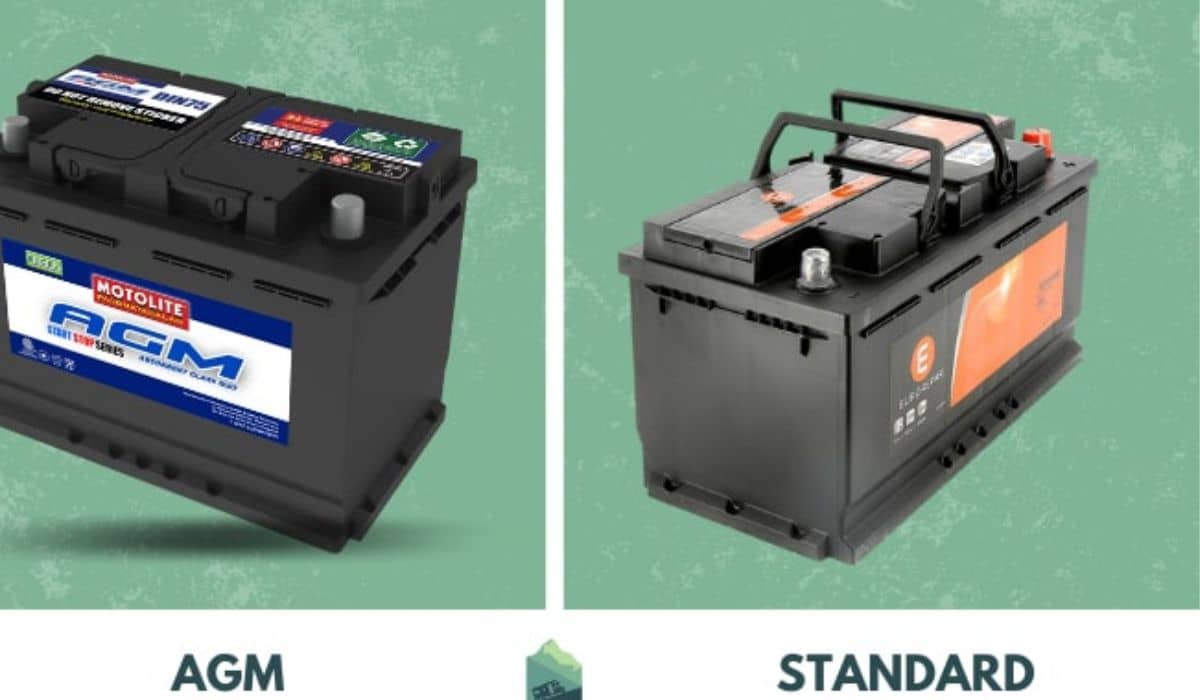Absorbed Glass Mat (AGM) and standard flooded (STD) lead-acid batteries are two popular types of rechargeable batteries used in a variety of applications today.
Both offer unique advantages and disadvantages in areas such as performance, lifespan, maintenance needs, cost, and more.
Whether you’re looking to power a solar system, RV, boat, golf cart or provide backup power to your home, understanding the key differences between AGM and flooded batteries is important. Read on to learn which battery is right for you.
AGM Batteries
What is an AGM Battery?
AGM stands for absorbent glass mat, describing the internal structure. These batteries have electrolyte suspended in fine fiberglass mats between the plates which prevents spills. Some key advantages are better charge acceptance, faster recharging, and ability to deeply discharge.
Advantages of AGM Batteries
Withstand vibration well due to tightly packed plates :
The absorbed glass mat immobilizes the battery plates and electrolyte inside the AGM battery. This tight packing prevents vibration damage.
Low self-discharge rate, about 3% per month :
AGM batteries lose only 2-3% of their charge per month when stored. This reduces maintenance charging requirements.
Disadvantages of AGM Batteries
Typically more expensive upfront cost :
The complex production process of glass mat assembly makes AGM batteries cost more to manufacture than basic flooded batteries.
Damaged by freezing temperatures :
Allowing an AGM battery to freeze can crack the battery case and warp plates. Temperatures below 0°F should be avoided.
Require voltage regulation to prevent under or over-charging :
AGM batteries can be damaged by excessive voltage variances outside tight thresholds. Charging systems must provide steady, regulated voltage control.
STD Batteries
What is an STD Battery?
STD refers to standard flooded lead-acid batteries where electrolyte fluid surrounds suspended lead plates. The “flooded” description refers to the liquid sulphuric acid that can leak out. These are most commonly used in vehicle starting applications.
Advantages of STD Batteries
Very low production costs keep pricing affordable :
Simple assembly with no mats or sealing makes flooded batteries much cheaper to manufacture.
Tolerate high temperatures well :
Flooded batteries function better than AGMs at extreme summer heat above 90°F.
Disadvantages of STD Batteries
Requires regular topping off of water :
Water evaporates from the battery over time requiring regular distilled water replacement to avoid damage.
Can leak acid when cracked causing safety issues :
Cracks in the battery case or overfills lead to dangerous acid leaks. Hazardous fumes are also released.
Comparison Between AGM and STD Batteries
Examining key differences that set these battery types apart helps match the right one for your needs.
Maintenance Needs
Flooded batteries require periodic checking and filling of water levels which AGM batteries never need due to the sealed construction. That makes them virtually maintenance-free besides recharging.
Toughness
The tight packed plates in AGM designs allow them to handle vibration better without performance degradation or mechanical damage. But STD batteries are generally thicker and can survive more impacts before failure.
Mounting and Spillage
AGM can be oriented in any direction without leaking while flooded batteries will spill dangerous acid when tipped beyond 45 degrees or cracked. STD types must remain upright to avoid safety hazards.
Internal Resistance and Power Output
AGM batteries have very low internal resistance allowing superior starting and quick power delivery even in cold weather. STD models have higher resistance slowing power release and limiting output especially in winter.
Charging Time
The suspended electrolyte in AGM penetrates the glass mats quickly supporting faster recharge rates. STD battery designs limit acid flow slowing charging speed and increasing time to fully recharge.
Depth Of Discharge
While STD batteries should not be discharged beyond 50% to avoid damage, AGM can withstand repetitive 80% depth cycles expanding usefulness for power storage. However, frequent 100% discharges will still shorten AGM life.
Temperature Tolerance
Flooded batteries are generally more resilient to temperature extremes on both ends of the spectrum. AGM batteries are damaged by freezing cold and typically underperform in high heat. Maintaining moderate temperatures will extend AGM battery lifespans.
Overcharging
AGM batteries require regulation to avoid overcharging damage while STD models can tolerate some overcharge levels through the escape of hydrogen gas. However, excessive high voltage charging still harms STD type lifespan.
Lifespan And Self-Discharge
Kept in optimal conditions, AGM averages 5 years service life but have about 3% capacity loss per month even when unused. STD batteries average 3-4 years of lifespan with lower monthly self-discharge rates around 2% when stored.
Corrosion And Sulfation
AGM batteries are less susceptible to corrosion and sulfation buildup that degrade capacity and lifespan. The sealed AGM chambers slow reactions while STD battery acid exposure accelerates deterioration.
Cost
Upfront acquisition cost of AGM batteries can run 2-3x higher than STD models. However, when factoring in lifecycle duration and reduced maintenance demands, the long-term investment value of AGM batteries improve greatly.
Uses
AGM Battery Advantages
Maintenance Free Operation :
AGM batteries require no external fluid checks or refilling. The immobilized electrolyte prevents the need for maintenance over their lifespan. Just proper charging practices are needed to maximize performance and longevity.
Vibration and Shock Resistance :
The reinforced glass mat physically supports the battery plates tightly while absorbing shocks, bumps, and vibrations that ruin other batteries over time. AGMs shrug off continuous rougher conditions.
Faster Recharging Capability :
With no fluid overflow dangers, AGM batteries allow higher amperage charging up to 5 times faster than flooded types. Most recharge to over 90% capacity within only 6 hours safely.
STD Battery Advantages
Extreme High Current Output :
The unique open internal design of flooded batteries permits very low internal resistance. This enables heavy current flows exceeding 1000+ amps for starting massive engines or powering high-draw equipment.
Lowest Upfront Cost :
Flooded batteries relatively simple assembly process allows very inexpensive production. This passes substantial upfront savings to the buyer despite shorter lifespans.
Easier Recycling :
Since flooded batteries require periodic replacement more often, their common lead-acid construction makes them the easiest traditional battery to recycle responsibly helping conserve resources.
Should You Pick an SLA Or an AGM Battery?
Determining whether an AGM or flooded battery is ideal for you depends primarily on a few key factors:
- Power and current demands – If you need high power above 400A, flooded is preferred. AGMs max out at around 400A for safe operation.
- Mounting orientation – AGMs can mount upright or sideways safely. Flooded must stay upright to avoid spills.
- Usage cycling – AGMs handle complete discharge cycles much better. Flooded don’t like deep cycles.
- Maintenance expectations – If you want no hassle, AGMs are nearly maintenance-free. Flooded need frequent servicing.
- Budget – Upfront, flooded are much cheaper. But over the long term AGMs cost less.
- Environment – AGMs withstand temperature extremes better and contain no hazardous emissions.
Weigh your unique needs against these factors. This should make it clear which battery type will perform better for your particular application and constraints.
If you value resilience, rapid charging, mobility, frequent cycling, and minimal maintenance – absorbent glass mat batteries are probably the ideal fit. They accept more abuse while requiring less servicing.
On the opposite end, if you desire very high power, the cheapest upfront cost, time to service regularly, and don’t need to mount sideways – standard flooded batteries align well. Just be prepared to maintain them diligently.
Can I Replace an SLA Battery With an AGM?
In most cases, you can upgrade from a flooded lead-acid to absorbent glass mat battery as long as size dimensions allow. Just be sure your charging systems provide the right voltage levels to avoid damage.
However, you cannot substitute AGM for cheaper flooded batteries without charging control modifications. Either choice still depends on your usage.
Conclusion
While flooded and AGM batteries certainly have distinct strengths and weaknesses that make each suitable to particular needs, AGM variants are superior across more general usage categories for most consumers.
Their durability, resilience, low maintenance operation, tolerance to repeated deep cycling, rapid recharging, and overall lifespan give them sizable advantages over flooded cells designed decades ago.
FAQ
What Are The Advantages Of Agm Batteries?
Some key advantages of AGM batteries are better charge acceptance, faster recharging, ability to deeply discharge, withstand vibration well, and no acid spills when damaged. They require very little maintenance besides recharging.
What Are The Disadvantages Of Std Batteries?
Disadvantages of flooded STD batteries include needing to regularly top off water, risk of dangerous acid leaks when cracked, damage when stored discharged, higher internal resistance limiting output, slower charging, and shorter 3-4 year average lifespan.
What Applications Are Agm Batteries Best For?
AGM works well in power sports vehicles, aviation, boats, battery banks, backups, and other deep cycle roles where length of power delivery or tolerance to motion matters more than low upfront costs.
Can You Replace A Regular Lead Acid Battery With An Agm?
Yes, in most cases you can upgrade from a flooded lead-acid STD battery to an AGM one as long as physical size allows. Just confirm your charging systems provide proper voltage regulation. Adding controls can enable the switch.
How Long Do Agm And Std Batteries Last?
AGM batteries kept in optimal conditions last an average of 5 years. Flooded STD lead acid batteries average 3-4 years lifespan. Various factors affect overall service life of both battery types before failing to hold sufficient usable capacity.
Continual improvements in AGM research have overcome their few past deficiencies compared to floodies as well.
Modern AGM batteries last longer, achieve better power density, and operate more efficiently than ever before thanks to progressing innovations that continue closing the gap.





